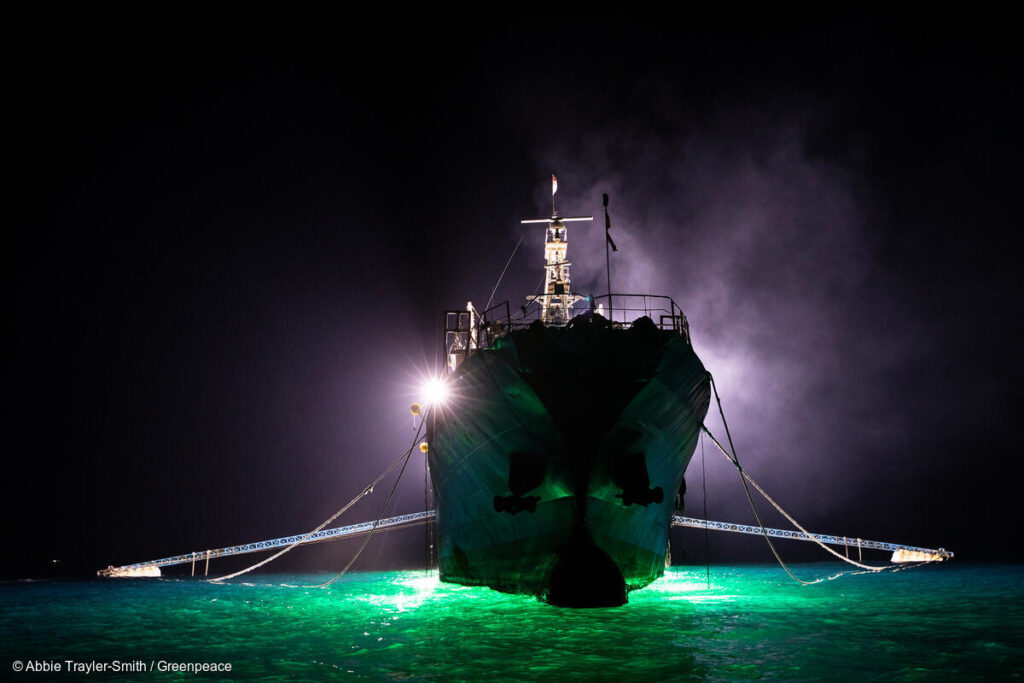ADF STAFF
A large trawler shined its huge, stadium-style lights into the deep waters of the western Indian Ocean.
The lights were meant to attract tuna and squid, but the trawler was using illegal driftnets — banned 30 years ago by the United Nations — and these nets hauled in sharks and manta rays about 500 miles off Somalia’s coast. Driftnets hang vertically from flotation devices dragged by fishing boats and can scoop up indiscriminate amounts of marine life.
In mid-April, Greenpeace released a report on the use of driftnets after spending two weeks tracking fishing vessels in the region. During its investigation, Greenpeace witnessed seven boats dragging two walls of driftnet more than 34 kilometers long and documented more than 100 squid-fishing vessels operating in the area without international regulation.
“We weren’t prepared for just how many [trawlers] we were able to see at night,” Will McCallum, head of oceans for Greenpeace UK, said in a video produced by Singaporean newspaper The Straits Times. “They’re fishing on this unbelievable scale, and it’s really surprising how little we know about just how they’re doing this fishing.”

The use of driftnets threatens East African fish stocks, which are especially low off the coasts of Kenya, Mozambique and Tanzania. The loss of fish drives food insecurity and threatens the job security of those who work in fishing-related trades.
“We have found that fish catches have been declining in Africa in recent years by a million tons a year, and … much of this decline in East Africa is due to declining fish stocks,” Tim McClanahan, author of a 2020 paper published in the journal Marine Ecology Progress Series, told sciencedaily.com.
Like bottom trawling, which drags nets along the ocean floor, removing up to 20% of the seafloor’s flora and fauna on a single pass, the use of driftnets often results in bycatch, or unwanted fish. Bycatch typically is thrown back into the water, dead or dying, a wasteful practice in East Africa, which Greenpeace regards as one of the world’s most ecologically vulnerable fishing grounds.
About one-third of assessed fish populations in the western Indian Ocean are overfished, Greenpeace reported.
In 2016, Sea Shepherd Global followed six Chinese fishing vessels in the Indian Ocean, one of which abandoned 4 kilometers of driftnet in the water as a Sea Shepherd vessel approached. Over two days, Sea Shepherd’s crew got the abandoned driftnet onto its own vessel and was able to release 18 live sharks back into the ocean.
However, the bodies of 321 animals were found dead in the netting, including sharks, dolphins, small pelagic fish, tuna and swordfish.
“Drift nets are particularly harmful because they are an indiscriminate killer, invisible curtains of death that catch any marine creature that blindly swims into them,” Peter Hammarstedt, Sea Shepherd’s director of campaigns, told ADF in an email.
The Greenpeace report called on governments to better enforce the ban on driftnets and for world leaders to reverse the trends of illegal fishing and declining fish stocks by agreeing to a Global Ocean Treaty through the U.N.
“This landmark treaty can create tools to turn back the clock on ocean destruction and resuscitate marine ecosystems, protecting invaluable species and sustaining coastal communities for generations to come,” McCallum said in a news release.

